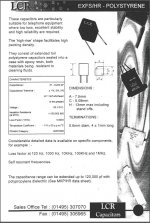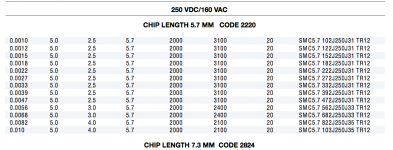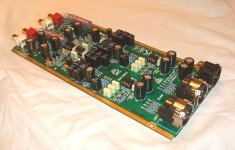I buy them from RS, but Ouupps, no 6.8nF :Bestellen Sie kp1830 online bei RS Components.
They are a bit expensive anyway and the stages i build with the Wimas sounded fine.
I also like Evox-Rifa PPS SMD. The same ones that the late Allen Wright used.
They are a bit expensive anyway and the stages i build with the Wimas sounded fine.
I also like Evox-Rifa PPS SMD. The same ones that the late Allen Wright used.
The tolerance is 5% but in praxis they are much better. They also have no steel caps and they solder like in heaven. https://www.distrelec.de/folienkond...0-vac/evox-rifa/smc5-7-682j250j33-tr12/828213
Hesener, could you modify the layout so that we can use them as an alternative ?
Sorry about the many wishes but i think we have narrowed in the choices.
Hesener, could you modify the layout so that we can use them as an alternative ?
Sorry about the many wishes but i think we have narrowed in the choices.
Yes, NOS Roederstein P-P, film and foil, axial and radial, are still possible to get but they are big. After some run in they are still some of the best you can get. Very thought after in the Far East and USA.
Post 3886 was for the Rifa PPS SMD.
Yes, i used the LCR Polystyren too. They come from Farnell and RS.
I hope nobody comes with the idea to build 10 versions with different caps and makes a shootout 🙂
Yes, i used the LCR Polystyren too. They come from Farnell and RS.
I hope nobody comes with the idea to build 10 versions with different caps and makes a shootout 🙂
LCR caps were very good quality. [Unfortunately they appear to have stopped making big electro caps for big PS use in higher voltages]. Very helpful and nice people to deal with direct. Unfortunately my health is up and down so I cannot offer to arrange a group buy.
A suggestion could als be these, when I set the values for the RIAA I had 6.8 nF in mind...TIN/Polystyrene film/foils.
These are my second best choice.... Very good.
Unfortunately the pin out is "over the edge" but maybe Hesener finds a way to implement those as an option too.
Strange, this cap discussion. Seem to make a huge difference to the sound for some.
Strange, this cap discussion. Seem to make a huge difference to the sound for some.
I have no sensor for that feeling, sorry. Honestly, i can hear small differences but when i read about magical differences i get sceptical. Sometimes i am playing tricks. One customer specified Mundorf Tin Foils after we had listened to a lot of other options. I then got an order to build a phono pre-pre from that customer and i had only a few days time to finish. I could not get hold of the tin foils quick enough and in desperation i fitted Intertechnik Q4. The resulting sound was just fine but the customer was eager to compare the tin foils later. So the customer fitted the tin foils. What happened was that they found the sound now a little on the soft side and they missed the dynamics of the Q4 so back in they went.
I know that speakers may be a totally different story as voltage and currents are much much bigger, but there the difference in types is much larger than i values, I can change from 3.3 uF to 4,7 uF in a filter and barely hear a difference, but if i change type (with the same value the difference can be night and day). I believe this is due to difference in the mechanics of the capacitor rather than electrical differences
As we won't find a solution for that everlasting cap discussion, I'd vote for a choice that pleases the ears, the stomach, and the measuring equimpment.
Personnally, I'd be fine with all cap types mentioned here.
Personnally, I'd be fine with all cap types mentioned here.
Yes, mechanics and also much higher current and voltage over the cap.
I disagree on the inaudibility of 3.3uf against 4.7uF. In some of my speakers where i fine tune a resonance it matters. Generally talking on the other hand a speaker that is plus-minus 2db from 50Hz to 15kHz is not easy to distinguish from one that is plus-minus 1dB provided the octave to octave balance is flat. I tested that by constructing an "artificial" speaker in LSP-CAD and listened over headphones. I even came up with a psychoacoustic curve that most listeners preferred to a straight curve provided it was in the 4dB channel. Was was very audible
was the amount of bass under 50Hz. When it was missing people complained at ones. I learned that a good selling speakers needs bass and most systems have too little of it in too bad quality so most systems sound like a puppet show. Some systems have of cause too much of it and in bad quality, that is even worse.
We could build a 3,3uF cap out of a lot of Wima FKP in parallel and hear how that sounds.
I disagree on the inaudibility of 3.3uf against 4.7uF. In some of my speakers where i fine tune a resonance it matters. Generally talking on the other hand a speaker that is plus-minus 2db from 50Hz to 15kHz is not easy to distinguish from one that is plus-minus 1dB provided the octave to octave balance is flat. I tested that by constructing an "artificial" speaker in LSP-CAD and listened over headphones. I even came up with a psychoacoustic curve that most listeners preferred to a straight curve provided it was in the 4dB channel. Was was very audible
was the amount of bass under 50Hz. When it was missing people complained at ones. I learned that a good selling speakers needs bass and most systems have too little of it in too bad quality so most systems sound like a puppet show. Some systems have of cause too much of it and in bad quality, that is even worse.
We could build a 3,3uF cap out of a lot of Wima FKP in parallel and hear how that sounds.
Holger, i agree. That is really an overrated issue and the mentioned options are good choices. Trouble is when you use very big caps. They would really spoil the layout here but for p2p it is just fine.
A while back you stated that some resistors tend to produce a "higher" soundstage.
For cart Rload I prefer shinko tatalums over other types.
Caps do also leave it´s signature .
I started making riaa filters using micas, than experimented with polystyrenes, MKP, Teflons and finally found polystyrenes & tinfoil to produce the best overall equilibrium between attack and presence.
It is a matter of taste of course but there are differences that can be clearly audible.
For cart Rload I prefer shinko tatalums over other types.
Caps do also leave it´s signature .
I started making riaa filters using micas, than experimented with polystyrenes, MKP, Teflons and finally found polystyrenes & tinfoil to produce the best overall equilibrium between attack and presence.
It is a matter of taste of course but there are differences that can be clearly audible.
HiRicardo,
my first approach was to put place for two caps so people could select and put whatever they want in parallel.... anyway, the choice right now is to put Wima FKP1 so I will change the footprint to that, should fit most others anyway.
what is the size and grid spacing of your caps, just curious?
My p2p program (ExpressPCB) uses 2,54mm spacement between holes.
The 40n cap is 9 holes long (23mm) and the 14n cap is 12 holes long (30.5mm)
These caps (obbligato MKP and RelCap styrenes) are not suitable for the boards due to it´s sizes but it is a very good sounding combination.
I will stick to the LCR styrenes available in Farnell as suggested by Miib 🙂 LCR COMPONENTS|EXFS/HR 6800PF +/- 1%|CAPACITOR, 6.8NF, 63V | Farnell Portugal
If a cap makes an audible difference depends a lot on the circuit. Last year for ETF i build a buffer box with a switch. 4 different caps could be switched in and a bypass. The input impedance of that buffer is very high so i could use 10nF without much loss in the bass.
The caps where NPO ceramic, Röderstein KP film-foil, Silver Mica and an unbespoken MKT. The difference was nill. The reason is the high input impedance. Caps only distort when some juice flows over them. Had the input impedance being much lower, maybe some differences had shown up. In a loudspeaker this is very different too. The loading resistor of a cartridge is sensitive too i found. I experienced differences in staging and tonal balance and have described them here. When the reference is established i am searching for affordable parts that perform nearly as good and cost much less. I find that more productive then simply throwing the "best" in the ring. That comes of cause from my professional background where working on a tight budged is common.
For example you build a preamp that costs 1000,-€ to make ( including overhead like keeping an office, lab, employees, etc ). To make profit in the real world it has to cost 6000,-€ in the shop or you have to close the company. For DIY this is much less of an issue of cause.
The caps where NPO ceramic, Röderstein KP film-foil, Silver Mica and an unbespoken MKT. The difference was nill. The reason is the high input impedance. Caps only distort when some juice flows over them. Had the input impedance being much lower, maybe some differences had shown up. In a loudspeaker this is very different too. The loading resistor of a cartridge is sensitive too i found. I experienced differences in staging and tonal balance and have described them here. When the reference is established i am searching for affordable parts that perform nearly as good and cost much less. I find that more productive then simply throwing the "best" in the ring. That comes of cause from my professional background where working on a tight budged is common.
For example you build a preamp that costs 1000,-€ to make ( including overhead like keeping an office, lab, employees, etc ). To make profit in the real world it has to cost 6000,-€ in the shop or you have to close the company. For DIY this is much less of an issue of cause.


